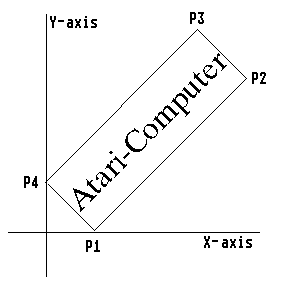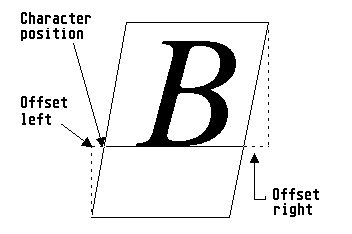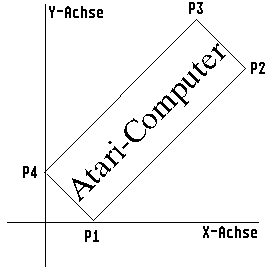| Parameter |
Meaning
|
| |
|
| handle |
Workstation identifier
|
| owflag |
Type of information:
|
| work_out[0] |
Type of screen:
| 0 = |
No screen
|
| 1 = |
Separate alpha and graphic controllers and separate video
memory
|
| 2 = |
Separate alpha and graphic controllers with shared video memory
|
| 3 = |
Common video and graphic controller with separate video memory
|
| 4 = |
Common alpha and graphic controller with shared video memory
(Note: All know devices return either 0 or 4)
|
|
| work_out[1] |
Number of colour levels (refers to the CLUT)
|
| work_out[2] |
Supported text effects (same bitmask as with vst_effects)
|
| work_out[3] |
Raster scaling flag:
| 0 = |
Scaling impossible
|
| 1 = |
Scaling possible
|
|
| work_out[4] |
Number of planes
|
| work_out[5] |
CLUT flag (0 = no CLUT, 1 = CLUT or pseudo-CLUT (TrueColor)
exists)
|
| work_out[6] |
Performance factor (number of 16*16 raster operations per
second)
|
| work_out[7] |
Contour fill capability (v_contourfill)
| 0 = |
Not supported
|
| 1 = |
Contour fill supported
|
|
| work_out[8] |
Text rotation ability:
| 0 = |
None
|
| 1 = |
In steps of 90 degrees only
|
| 2 = |
In steps of 1/10 degree
|
|
| work_out[9] |
Number of writing modes available
|
| work_out[10] |
Highest available input levels:
| 0 = |
None
|
| 1 = |
Request
|
| 2 = |
Request and sample
|
|
| work_out[11] |
Text alignment capability flag:
| 0 = |
Not available
|
| 1 = |
Available
|
|
| work_out[12] |
Inking capability flag:
| 0 = |
Device cannot ink
|
| 1 = |
Device can ink
|
|
| work_out[13] |
Rubberbanding capability flag:
| 0 = |
No rubberbanding
|
| 1 = |
Capable of rubberband lines
|
| 2 = |
Capable of rubberband lines and rectangles
|
|
| work_out[14] |
Maximum number of input vertices for v_pline, v_pmarker,
v_fillarea, or -1 (unlimited)
|
| work_out[15] |
Maximum number of intin arguments, or -1 (no limit)
|
| work_out[16] |
Number of mouse buttons
|
| work_out[17] |
Line types for wide lines:
|
| work_out[18] |
Number of writing modes available for wide lines.
|
| work_out[19] |
Clipping flag:
Only PC-GEM as of version 2.0 and NVDI.
|
| work_out[20] |
| 0 = |
No extended precision pixel size information is available
|
| 1 = |
Pixel size is in 1/10 microns
|
| 2 = |
Pixel size is in 1/100 microns
|
| 3 = |
Pixel size is in 1/1000 microns
|
|
| work_out[21] |
Pixel width in 1/10, 1/100 or 1/1000 microns, like work_out[20]
|
| work_out[22] |
Pixel height in 1/10, 1/100 or 1/1000 microns, like
work_out[20]
|
| work_out[23] |
Horizontal resolution in dpi
|
| work_out[24] |
Vertical resolution in dpi
|
| work_out[25] |
Flag to indicate whether bit-image files on printers can be
rotated by the driver (as of PC-GEM/3):
| 0 = |
No
|
| 1 = |
Rotation in 0,90,180,270 degrees possible
|
|
| work_out[26] |
+
|
| work_out[27] |
Address of the screen buffer (1/4 of the screen area) that is
used with AES functions (only as of PC-GEM/3)
|
| work_out[28] |
Bezier flag:
| Bit-1 = |
Driver has no Bezier capability (0), or driver has Bezier
capability (1)
|
This information is available as of PC-GEM/3 as well as under
NVDI
|
| work_out[30] |
Raster flag:
| Bit-0 = 1 |
vrt/vro_cpyfm is capable of scaling bitmaps
|
| Bit-1 = 1 |
New raster function present, as of NVDI 5.00
|
| Bit-2 = 1 |
New vr_clip_rects_xxx clipping function present, as of
NVDI 5.02
|
|
| work_out[32] |
| Bit-0 = 1 |
New style color routines (NVDI 5.xx)
|
|
| work_out[40] |
Non-printable left margin in pixels (printers/plotters)
|
| work_out[41] |
Non-printable top margin in pixels (printers/plotters)
|
| work_out[42] |
Non-printable right margin in pixels (printers/plotters)
|
| work_out[43] |
Non-printable bottom margin in pixels (printers/plotters)
|
| work_out[44] |
Page size (printers etc.):
|
| work_out[45] |
Top left X-coordinate, and
|
| work_out[46] |
Top left Y-coordinate of the clipping rectangle
|
| work_out[47] |
Bottom right X-coordinate, and
|
| work_out[48] |
Bottom right Y-coordinate of the clipping rectangle
|
| work_out[49] |
|
| : |
|
| : |
|
| work_out[56] |
Reserved, contain zero
|



